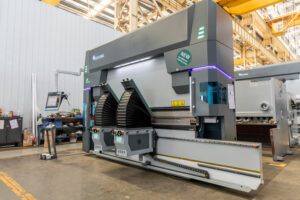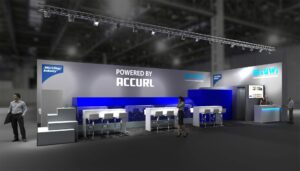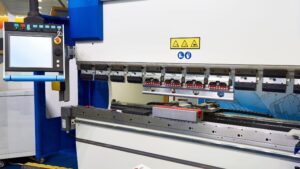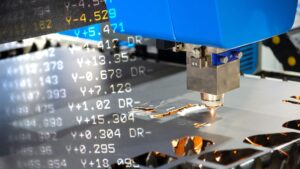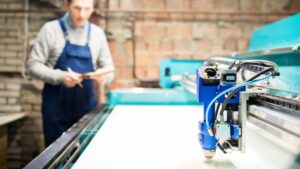When it comes to precision and efficiency, laser cutting aluminum is a technique that stands out. This comprehensive guide aims to cover every nook and cranny of aluminum laser cutting, from its basic principles to its advanced technologies. Whether you’re a manufacturer or a DIY enthusiast, understanding the capabilities and parameters of this cutting-edge method can unlock new avenues for your projects.
Metal laser cutting is the process of using a focused laser beam to cut metal materials, a technique that has revolutionized metal fabrication, especially when it comes to aluminum. Unlike traditional cutting methods, laser cutting provides precision, speed, and versatility, making it highly sought after in various industries.
Can Aluminum Be Cut With a Laser?
Certainly, aluminum can be cut using a laser, but the process presents unique challenges compared to cutting other metals like carbon steel. The high reflectivity and thermal conductivity of aluminum can affect the laser beam’s power density and focus, potentially hindering the cut quality. Understanding the specific nuances of cutting aluminum with a laser is crucial for achieving the best results.
How Does Laser Cutting of Aluminum Work?
Before diving into the complexities, let’s first establish the main stages of laser cutting aluminum.
Programming the Machine
The first step is to program the laser cutting machine with specialized software. At this stage, experts set the cutting parameters, ensuring that the laser power, speed, and feed rate are correctly adjusted to match the material being cut—in this case, aluminum. The software also contains a menu where different cutting modes can be selected based on the desired results.
- Cutting Parameters: These determine how the machine will behave. For example, the speed at which the laser moves across the material and the power levels of the laser.
- Material Properties: Information on the aluminum sheet’s grade, thickness, and thermal conductivity is essential for accurate programming.
- Job Queue: The software allows the user to line up multiple jobs, increasing overall productivity.
Material Loading
The next stage involves placing the aluminum sheet on the cutting table. Material handling is critical to ensure that the aluminum lies flat, preventing any potential problems during the cutting process.
- Material Orientation: The aluminum sheet must be aligned properly on the cutting table. Even a small misalignment can lead to cut quality issues.
- Material Thickness: Different thicknesses require different settings; this is part of the reason why proper loading is crucial.
- Material Grade: Using the correct grade of aluminum is vital. Grades like 6061 and 5052 are commonly chosen for their machinability and weldability.
Calibrating the Laser
Calibration involves adjusting the laser’s power density and focus point. The focus point is particularly important when cutting aluminum, a highly reflective material, to avoid scattering the laser beam and potentially damaging the machine’s optics.
- Power Density: Higher power density typically allows for faster cuts, but it also impacts heat input and, subsequently, the cut quality.
- Focus Point: The ideal focus point varies depending on the aluminum sheet’s reflectivity and thermal conductivity.
- Assist Gas: Operators often use nitrogen or other gases to improve the cut, especially when dealing with aluminum alloys that have different properties.
Cutting Process
This is where the laser beam interacts with the material. In aluminum, the laser beam’s speed and power must be carefully managed to ensure a clean cut, considering the metal’s thermal conductivity and reflective nature.
- Feed Rate: The speed at which the cutting head moves over the material affects both the quality of the cut and the machine’s efficiency.
- Laser Power: Adjusting the laser power according to the material’s characteristics ensures effective cutting.
- Cutting Head: The cutting head is precisely aligned to make sure the laser hits the material at the optimal angle.
Post-Processing
After cutting, the next step is the removal of dross and smoothing the edges. This step is often overlooked but crucial for achieving the kind of high-quality, finished product that industries like aerospace or medical devices demand.
- Dross Removal: Leftover material known as dross needs to be removed to ensure the final product meets quality standards.
- Edge Smoothing: This is often done to remove any sharp edges, improving the part’s overall finish and safety.
- Additional Treatments: Sometimes additional processes like coating or oxidation removal may be necessary, depending on the application.
A Historical Perspective on Laser Cutting Aluminum
Historically, the practice of laser cutting aluminum has come a long way from its humble beginnings. The technique emerged as an offshoot of CO2 laser technology, which initially struggled with aluminum’s specific properties like reflectivity and thermal conductivity. Innovations in fiber laser technology have made it much easier and efficient to laser cut aluminum, resulting in wider industry adoption.
What Are the Different Types of Laser Cutters Used for Cutting Aluminum?
When it comes to the types of laser cutters suitable for aluminum, there are a few options to consider, each with its own pros and cons.
Fiber Laser Cutters
Fiber laser cutting is known for its speed and energy efficiency. These machines utilize diode-generated lasers, amplified through fiber-optic cables. The diodes are organized into modules, typically the size of a small briefcase, that can vary in power from 600 to 1,500 watts. When coupled together, these modules form the final powered resonator, which amplifies the laser beam channeled through the fiber-optic cables. With a wall plug efficiency of over 40%, fiber laser machines are highly energy-efficient.
However, the same features that make fiber lasers a great choice for cutting other metals like carbon steel present challenges when cutting aluminum. Aluminum’s high reflectivity can interfere with the laser beam, affecting the cut quality. Additionally, fiber lasers are generally faster when cutting certain metal thicknesses, but the speed advantage can diminish when it comes to processing highly reflective materials like aluminum.
Attributes of Fiber Laser Cutters:
- Wall Plug Efficiency: Over 40%, ensuring lower energy consumption.
- Speed: Generally faster, although reflective materials like aluminum can reduce speed advantages.
- Laser Power: Can vary between 600 to 1,500 watts, influencing the thickness of the material that can be cut.
- Challenges: Difficulty in cutting highly reflective materials.
CO2 Laser Cutters
CO2 laser cutters operate on a fundamentally different principle. These machines generate laser beams through electrically-stimulated CO2 gas. Because of the electricity and gas combination, CO2 laser cutters require more energy and, consequently, large chillers. Unlike fiber lasers, CO2 lasers suffer from a lower wall plug efficiency, resulting in higher operational costs.
However, where CO2 lasers shine is in their ability to cut reflective materials like aluminum more effectively. This compensates for their higher operational costs and makes them a strong contender for specific aluminum cutting tasks.
Characteristics of CO2 Laser Cutters:
- Energy Consumption: Higher due to the electrical stimulation of CO2 gas.
- Cutting Reflective Materials: More effective compared to fiber lasers.
- Operational Costs: Generally higher due to lower wall plug efficiency.
- Applications: Best suited for cutting reflective materials, despite higher operational costs.
Solid-State Lasers
Solid-state lasers are not as commonly used in industrial settings, but they offer superior beam quality. This makes them highly suitable for intricate designs where precision is crucial. These lasers use solid gain media, typically doped crystals, to generate the laser beams. Although they offer high beam quality, they are generally less efficient than their fiber and CO2 counterparts when it comes to energy utilization.
The main drawback of using solid-state lasers for cutting aluminum is their struggle with the material’s high reflectivity, much like fiber lasers. However, they offer a niche advantage in applications where the design intricacy is a greater priority than speed or efficiency.
Qualities of Solid-State Lasers:
- Beam Quality: Exceptional, suitable for intricate designs.
- Energy Efficiency: Generally lower compared to fiber and CO2 lasers.
- Applications: Limited, but excels in jobs requiring high precision.
- Challenges: Struggles with highly reflective materials like aluminum.
Specifics of Laser Cutting Aluminum
Cutting aluminum with lasers presents its unique set of challenges and considerations.
The Aluminum Oxide Film
Aluminum naturally forms an oxide film on its surface. While this film is advantageous for corrosion resistance, it can interfere with the laser cutting process by scattering the laser beam.
Viscosity and Thermal Conductivity
Aluminum’s high thermal conductivity means that heat disperses quickly, affecting the cut quality. Moreover, its low viscosity can lead to poor edge quality.
Assist Gas Flow and the Laser Focus
The use of assist gases like nitrogen and oxygen plays a critical role in achieving clean cuts. Moreover, calibrating the laser’s focus point is essential for optimal cut quality.
How to Optimize the Laser Cutting Process?
To achieve the best results, consider tweaking settings like:
- Cutting focus
- Speed
- Output power
- Air pressure
What Are the Main Parts of a Laser Cutter for Aluminum?
A typical laser cutter for aluminum consists of several main components:
- Laser Source: Generates the laser beam.
- Cutting Head: Focuses and directs the laser.
- Assist Gas Delivery System: Supplies assist gas to improve cut quality.
- Control Panel: Houses the software interface for machine programming.
- Cutting Table: Holds the material being cut.
H2: What Are the Main Parameters for Laser Cutting Aluminum?
Understanding the main parameters for laser cutting aluminum is essential for achieving optimal results.
What Are the Cutting Tolerances for Aluminum Laser Cutting?
Cutting tolerances refer to the allowable deviation from specified dimensions, which can range from a few microns to several millimeters, depending on the machine and settings.
How Thick of an Aluminum Sheet Can Be Laser Cut?
The thickness of the aluminum sheet that can be laser cut depends on the laser’s power levels. Typically, sheets up to 1 inch can be cut, although this can vary.
What Is the Best Grade of Aluminum for Laser Cutting?
When it comes to grades, 6061 and 5052 aluminum are among the best options for laser cutting due to their good machinability and weldability.
What Are the Advantages and Challenges of Laser Cutting Aluminum?
Laser cutting aluminum comes with its own set of advantages and challenges that one must consider.
Advantages of Laser Cutting Aluminum
High Precision
One of the most significant benefits of laser cutting aluminum is the high precision it offers. Whether you’re dealing with fiber lasers or CO2 lasers, the laser beam can be focused down to a fraction of a millimeter, allowing for intricate shapes and patterns to be cut with incredible accuracy.
Speed
Time is of the essence in any manufacturing process, and laser cutting aluminum is no different. With high power density and quick feed rates, the laser cutting process significantly reduces the time needed to cut through aluminum sheets or plates.
Versatility
The application range of laser cutting aluminum is broad. With adjustable settings and focus points, one can cut different thicknesses and types of aluminum alloys, making the method incredibly versatile.
Additional Advantages
- Laser Power: Adjustable, ensuring that you can cut through different thicknesses.
- Cut Quality: Produces cleaner edges with little to no burr.
- Wavelength: Allows for adjustment to suit material characteristics.
- Automated Operation: Minimizes human error and streamlines the production process.
Challenges in Laser Cutting Aluminum
High Reflectivity
Aluminum’s high reflectivity poses a significant challenge when using certain types of laser cutters, especially fiber lasers. The reflective material can cause the laser beam to scatter, affecting cut quality.
Thermal Conductivity
Aluminum’s high thermal conductivity can also be problematic. It can lead to a rapid dissipation of heat, which might affect the laser’s efficiency and the overall quality of the cut.
Cost
Despite the advantages, laser cutting aluminum is generally more expensive than other methods like plasma cutting or water jet cutting. The initial investment for laser cutting machines can be steep.
Additional Challenges
- Cutting Parameters: Need careful adjustment to handle aluminum’s unique properties.
- Gas Mixture: Choice of assist gas can influence the cutting process.
- Maintenance: Reflective material can cause wear and tear on the machine’s optics.
- Power Levels: May require adjustment to compensate for aluminum’s thermal conductivity.
Is Laser Cutting Aluminum Expensive?
While the use of laser cutting for aluminum does entail higher operational costs than methods like plasma cutting, these are often justified by the level of precision and versatility it offers. The initial investment in a quality laser cutting machine can be significant. However, the results often lead to more efficient production and less waste, providing a strong return on investment over time
Which Industries Utilize Laser Cutting for Aluminum?
Laser cutting aluminum has extensive applications across multiple industries.
- In aerospace, the need for lightweight yet strong components makes laser-cut aluminum an ideal choice.
- Automotive industries also utilize laser cutting for parts that demand high precision.
- Construction sectors employ this technique for structural elements, and even the medical devices industry has found uses for laser-cut aluminum.
Additional Industries
- Manufacturing: For bulk production of components.
- Design: In the creation of intricate architectural or artistic pieces.
- Energy: Specifically in renewable energy infrastructure.
- Electronics: For components like heat sinks that require precise dimensions.
Key Factors and Mistakes to Consider When Laser Cutting Aluminum
Key factors to consider include:
- Material Thickness
- Assist Gas Type
- Laser Power
Common mistakes to avoid include:
- Incorrect Focus Point
- Insufficient Assist Gas Flow
- Wrong Cutting Speed
Practical Guide: How to Laser Cut Aluminum?
Before you can begin the laser cutting process, there are essential preparations you need to consider. It all starts with material selection; remember, not all aluminum grades are the same. Different grades possess distinct characteristics, such as thermal conductivity, that can affect your laser cutting’s effectiveness.
Preparations Before Laser Cutting Aluminum
Select the correct grade and thickness of aluminum:
- Aluminum Grades: Depending on the application and mechanical properties you need, the grade of aluminum you select may vary. 6061 and 5052 are among the commonly used grades.
- Thickness: The thickness of the aluminum sheet or plate will influence both your laser settings and cutting speed.
Calibrate the laser settings:
- Power Levels and Speed: These are influenced by the grade and thickness of the aluminum. Make sure to check the manufacturer’s recommendations.
- Focus Point and Beam Quality: A stable focus point and high-quality laser beam are crucial for achieving the best cut.
Prepare the cutting table:
- Support Bars: Make sure that the support bars are clean and correctly positioned to avoid surface scratches.
- Nozzle and Cutting Head: These should be aligned properly to ensure that the laser beam hits the material at the optimal angle.
- Test Run: Conducting a test run on a scrap piece can provide valuable information and allow for necessary adjustments.
Safety Tips for Laser Cutting Aluminum
Safety should never be compromised. The laser cutting process involves high levels of heat and light, so proper protective measures should be in place.
Always wear protective gear.
- Goggles: To protect your eyes from intense light and sparks.
- Heat-Resistant Gloves: To safeguard against burns when handling hot materials.
Ensure proper ventilation.
- Exhaust Fans: Ensure that exhaust fans are working to draw fumes away from the work area.
- Air Quality: Monitoring air quality can provide a safer and more comfortable working environment.
Design Tips for Laser Cutting Aluminum
Your design can make or break the efficiency of your laser cutting process. Different thicknesses of aluminum sheets have their own set of challenges, so you’ll need to adjust your design accordingly.
Avoid intricate designs for thicker sheets.
- Complexity and Detail: The thicker the sheet, the less suitable it is for complex and intricate designs, owing to factors like kerf width.
- CAD Software: Using CAD software ensures that your design is translated accurately during the cutting process.
Use CAD software for accurate programming.
- File Types: Ensure that you use compatible file types like .DXF or .AI for smooth programming.
- Templates: Some cutting software offers templates that can save time and reduce the chance of errors.
Additional Tips:
- Double-Check Dimensions: Before starting the actual cutting process, always double-check the dimensions to minimize waste.
- Opt for Professional Laser Cutting Services: If the design is complex or the volume is high, opting for professional laser cutting services may provide better results at a more competitive price.
How Much Does Laser Cutting Aluminum Cost?
. Generally, the cost per hour for laser cutting aluminum can range from $50 to $300. But hold on, this is not a one-size-fits-all answer.
- Project Complexity: The more complex the design, the higher the price. Intricate cuts may require slower cutting speeds, which increases the time and, therefore, the cost.
- Laser Cutting Machine Efficiency: The type of laser cutter used, such as fiber laser machines or CO2 lasers, can also impact the cost. Fiber lasers usually offer faster cutting speeds, potentially reducing labor costs.
- Material Costs: Aluminum sheets come in various grades and thicknesses, each with its own price tag. High-quality or specialized aluminum alloys will bump up the material cost.
- Post-Processing: Some projects may need additional finishing treatments like coating or oxidation removal, which add to the total cost.
- Geographic Location: Rates may also vary based on where the laser cutting service is located. Costs can differ significantly between regions and countries, so you might want to look into this factor.
How Much Does a Laser Cutter for Aluminum Cost?
f you’re considering a long-term investment in laser cutting technology for aluminum, you’ll need to prepare for a significant upfront cost. The price for a laser cutter suitable for cutting aluminum can start from $20,000 and can go up to over $100,000. While this might seem steep, the benefits can be worth it.
- Features and Capabilities: The more features your machine has—like high cutting speeds, efficient power density, and automated settings—the higher the price.
- Brand: Established brands known for quality and reliability, such as ACCURL, generally cost more than lesser-known brands.
- Laser Power: Machines with higher laser power capabilities will generally cost more but will also provide faster cutting and better cut quality.
- Maintenance and Consumables: While fiber laser machines are relatively low maintenance, CO2 laser cutters require more in terms of consumables and upkeep.
- Add-ons and Upgrades: Specialized cutting heads, lenses, or other optional features will add to the overall cost.
What Are the Best Laser Cutting Machines for Aluminum?
Quality, reliability, and efficiency are key factors to consider when selecting a laser cutting machine for aluminum. Here’s a list of what to look for in a laser cutter for this specialized application.
- High Cutting Speeds: Look for a machine with high cutting speeds, especially if you are involved in production where time is a critical factor.
- Precision and Accuracy: A machine that offers high levels of precision will result in better cut quality.
- Ease of Use: A user-friendly interface and easily programmable settings can make a huge difference in your day-to-day operations.
- Low Maintenance: Fiber laser machines often require less maintenance compared to CO2 lasers.
ACCURL Machines: One notable example is ACCURL, renowned for their meticulous engineering and impressive performance. With a focus on high dynamics and top-quality outcomes, ACCURL fiber laser cutting machines are a reliable choice. The machine’s architecture is designed for high-energy 2D fiber laser cutting and can achieve positioning speeds of up to 180m/min. What sets them apart?
- Extremely Durable Frames: Their steel frames undergo annealing at over 600⁰ to relieve stress, ensuring durability.
- Sophisticated Engineering: Utilizing high-tech boring machines and electric welding for high precision parts, their meticulous attention to detail shows in the end product.
- Customization: They offer customized fiber laser cutting solutions that range from entry-level to high-end machines, catering to different industry needs and budget constraints.
Alternatives to Laser Cutting Aluminum
While laser cutting aluminum offers many advantages, there are alternative methods to consider, each with its pros and cons.
- Water Jet Cutting: Effective for thicker materials but may not offer the same level of detail as laser cutting.
- Plasma Cutting: Suited for heavy-duty tasks, yet lacks the precision of laser cutting.
- Mechanical Cutting: An older method that is less precise and may cause material deformation.
Understanding the full scope of your project’s requirements, including cost and material constraints, can help you select the most appropriate cutting method.
Conclusion
Laser cutting aluminum has proven to be a game-changer in metal fabrication, offering unparalleled precision, speed, and versatility across diverse industries. Whether you opt for a fiber laser machine or a CO2 laser cutter, understanding the unique challenges and optimizations of cutting aluminum can drastically improve your project outcomes.
This comprehensive guide delves into every aspect, from machine selection and safety protocols to cost factors and industry applications, aiming to be your go-to resource for all things related to laser cutting aluminum.


